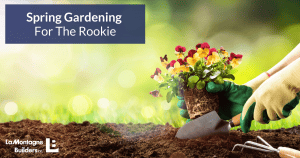Spring Gardening For The Rookie

Know your zone. The U.S. Department of Agriculture created a Plant Hardiness Zone map that designates a number to every area of the country based on climate conditions. It’s the standard for determining how well plants will grow. Based on our state’s cold winters, most of southern and central New Hampshire falls into zones 5a and 5b. Use this information to select flowers and plants that will have the best chance to thrive. The zone and type of plant will also inform you on the best time of year to put those seeds or starter plants into the ground. To find your exact zone, enter your zip code into a hardiness map available online.
Set an end goal. Think about what you want to accomplish and what would make you happy this season. Do you want a relaxing retreat in the backyard? A kitchen stocked with homegrown veggies and herbs? Curb appeal in your front yard? Experts advise not taking on too much at once. If you’re brand new to gardening, start with a small, manageable project that will feel like a success. You can always add on to it in future seasons.
Map it out. You can sketch a simple hand-drawing of the area you want to plant in with details on how you’d like to style it. Or arrange a collection of vision board-inspired photos you’ve collected along with magazine clippings. There also are several options for interactive garden planners online. Use the method that will help you best visualize the final garden result, keeping sizes and space in mind.
Consider containers. If you want to avoid intense planning, or the commitment of digging into your ground and modifying the landscape, containers are a great option for both decorative and food gardens. A grand front entrance or zen oasis may feature an assortment of fragrant, lush plants in pots and planters. Herbs can be easily cultivated in vertical gardens and tall containers, and a wide variety of vegetables can be grown in raised beds. Containers also make it easier to protect your plants from pesky wildlife and critters. Another benefit is that you can control the nutrients in the soil better than in the ground.
Go low maintenance. Once your garden is planted, you’ll want to enjoy it without putting too much heavy work into it. Look for ways to make it easy to care for, such as using crushed stone in your beds. It’s a good alternative to mulch because you don’t have to replace it, which can save time and money. When it comes to plants and flowers, perennials are easier than annuals. They’ll come back year after year. Hostas are a popular choice. They can thrive in almost every zone and fit into many different kinds of gardens or locations. Choosing non-fussy flowers is a good idea, too. Of course, the ones you plant depend on your soil and levels of sun exposure in the area of your garden. You don’t want to have to worry or spend too much time nurturing fragile plants.
Don’t forget tools. They don’t have to be the most expensive with all kinds of features — the basics will do just fine to start. Ready to dig in and get your hands dirty? Share your photos of your gardens with us!